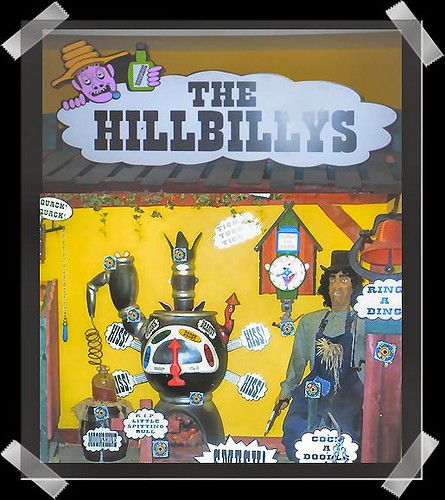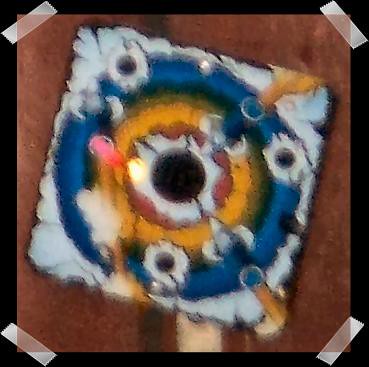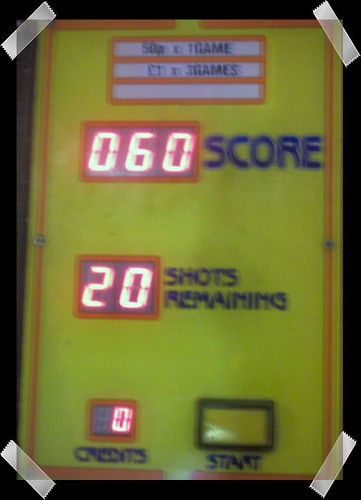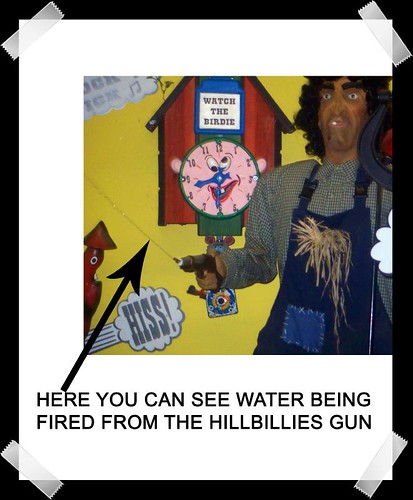The environment at UCI was very noisy and there were lots of flashing lights and sounds trying to entice you to part with your cash. Due to the time of our visit there were no children at the arcade but there were a few adults which told me that the games are designed with both adults and children alike.
The exhibit I chose to explore was called "The Hillbillies"

The Hillbillies is a target shooting game which can be played by up to six different players at any one time. The object of the game is to get as many points as you can by successfully hitting the targets with a life sized plastic replica of a rifle. There are sixteen targets in total which are situated around the scene of a Hillbillies shack with a life sized hillbilly with a gun in his hand. As you will see from the photo below the targets are square in shape and have a circle with inners inside.

There are also archery arrows illustrated to look like they’re coming out of the targets. The metaphor of the arrows in the target confirms to the user that it is indeed the target. The user would use previous knowledge in this cognitive process to recognise the targets.
When you insert money in the slot the simple interface displays your score, the number of shots remaining and the amount of credits you have left. There is also a start button on the interface.
This is a photo of the interface.

The player gets twenty shots for one game and each target successfully hit scores ten points. To start the game you need to press the start button. There is no flashing light on the start button and there is no signal to indicate the game had started or any indication that you are firing shots apart from a minute click that is emitted from the gun. When I played I found that hearing the gun firing was impossible to hear especially with all the noise and commotions going on in and around the arcade. I only realised I’d taken any shots when I looked on the interface and saw I had only 15 shots remaining. I think the noise should be louder so you know the game has started and is working. The simple interface has limited information and does not converse with the user or instruct the user in any way.
The game uses infra-red beams and sensors, infra-red beams are fired from the rifle to the targets. When the beam successfully hit’s a sensor on one of the sixteen targets it triggers a reaction from the object in the scene that the target is on. All targets reactions are different e.g. the cuckoo pops out of the clock., the shack door opens and a monkey squirts water at you, the bell rings and the Hillbilly stands up and shoots water at you out of is gun. All the reactions make a noise too egg the Hillbilly shouts and the monkey laughs. There is no time limit on the game and it finishes when all 20 shots have been taken

The design of the game uses some of Gestalt design recommendations. It has easily distinguishable objects, good affordances e.g. the rifle affords to be fired.. HCI principles that are applied are that it’s enjoyable and entertaining for the user to play. The bright flashing lights and the moving objects and loud sounds ejected from the game entice the user to part with the cash. Many people enjoy this kind of simulation game because they get to fire a rifle which is not something that they can do in the real world. The chance to shoot without consequence appeals to the user.
By allowing six players to play at one time adds a competitive edge to the game and encourages players to part with more cash for the chance to get a higher score than the others. The exhibits reflect this in their design. They are designed so they are addictive to play therefore getting you to keep putting more and more money in as you try to complete the game
This is me playing the Hillbillies

The main differences between the exhibits here at UCI and those at Techniquest are
You are required to put money in the games at UCI to be able to play them. The exhibits reflect this in their design. They are designed so they are addictive to play therefore getting you to keep putting more and more money in as you try to complete the game
The exhibits at Techniquest are educational and teach children about science but the exhibits at UCI do not have an educational aspect to them.
Many of the games at UCI represent real life in some way but most of them are based on weapons, violence and fighting. Promoting violence is not a good message to be going out to children.
The environment at UCI was very dark and noisy and there were lots of flashing lights and sounds trying to entice you to part with your cash. The atmosphere at Techniquest wasn’t as noisy and it had large floor to ceiling windows with views of the bay.
Even though I enjoyed both the trip to Techniquest and the trip to the UCI amusement arcade my favourite had to be Techniquest. Techniquest was great fun and being a parent myself I was impressed in the various innovative and exciting ways that science was illustrated by the exhibits.


No comments:
Post a Comment